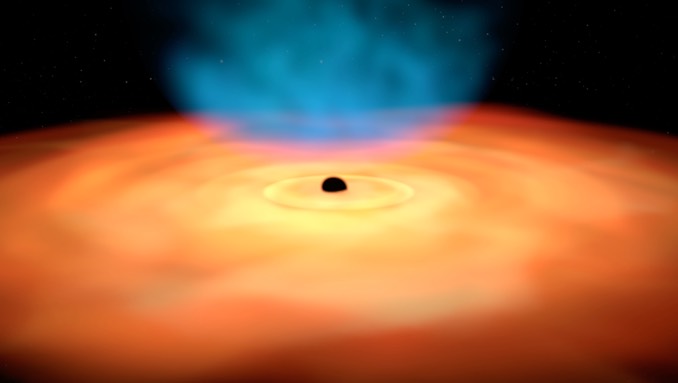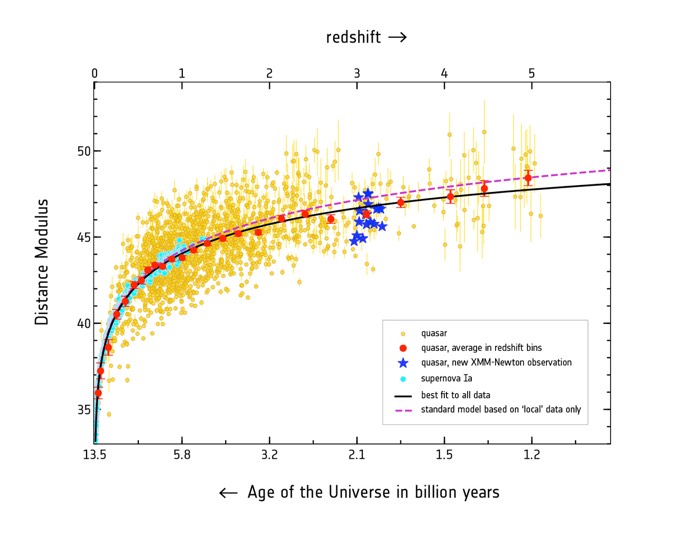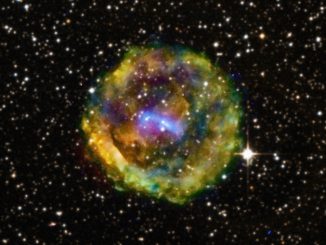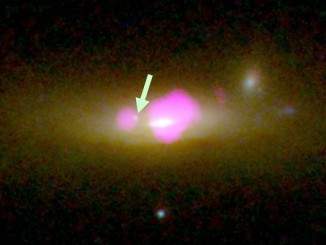
X-ray observations of some 1,600 quasars, galaxies harboring active supermassive black holes in their cores, indicate that dark energy, the mysterious force causing the expansion of the universe to accelerate, may not be a “cosmological constant” after all. It may instead be growing stronger over cosmic time.
Dark energy was discovered about 20 years ago based on observations of type 1a supernovae, explosions in binary star systems that generate the same levels of brightness. By comparing a type 1a supernova’s apparent brightness with its known absolute luminosity, astronomers can use them as “standard candles” to measure the distance to the host galaxy.
After precisely measuring the distances and velocities of some four dozen type 1a supernovae, researchers concluded the expansion of the universe began speeding up about 6 billion years ago. The dark energy powering that acceleration was thought to be a constant, overpowering the collective gravity of normal and dark matter only when the universe had expanded and thinned out enough in the wake of the Big Bang.
Distances based on type 1a supernova measurements chart the effects of dark energy over the past 9 billion years or so. The new X-ray observations, led by Guido Risaliti of Università di Firenze, Italy, and Elisabeta Lusso of Durham University in the UK, push that limit all the way back to the first billion years or so after the Big Bang. And those observations indicate dark energy may not be so constant after all.
In quasars, the disk of material swirling around a supermassive black hole emits ultraviolet radiation, some of which hits electrons in clouds of gas above and below the disc, heating them up enough to generate X-rays. A known correlation between the observed UV and X-ray radiation allowed Risaliti and Lusso to use quasars as standard candles, showing the effects of dark energy back to within about a billion years of the Big Bang.

“Using quasars as standard candles has great potential, since we can observe them out to much greater distances from us than type-Ia supernovas, and so use them to probe much earlier epochs in the history of the cosmos,” said Lusso.
The researchers collected X-ray data for over 7,000 quasars in the European Space Agency’s XMM-Newton archive and combined that with UV observations from the Sloan Digital Sky Survey. They also considered a small number of even more remote quasars, as well as a few nearby sources, that were observed with NASA’s Chandra and Swift X-ray observatories.
The sample size eventually was reduced to about 1,600 quasars, those with the clearest UV/X-ray correlation.
“When we combine the quasar sample, which spans almost 12 billion years of cosmic history, with the more local sample of type-Ia supernovas, covering only the past eight billion years or so, we find similar results in the overlapping epochs,” Lusso said in a release.
“However, in the earlier phases that we can only probe with quasars, we find a discrepancy between the observed evolution of the Universe and what we would predict based on the standard cosmological model.”



